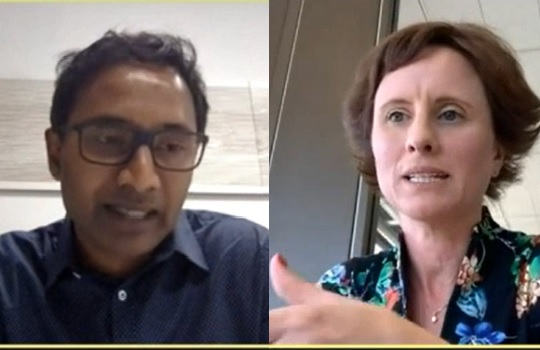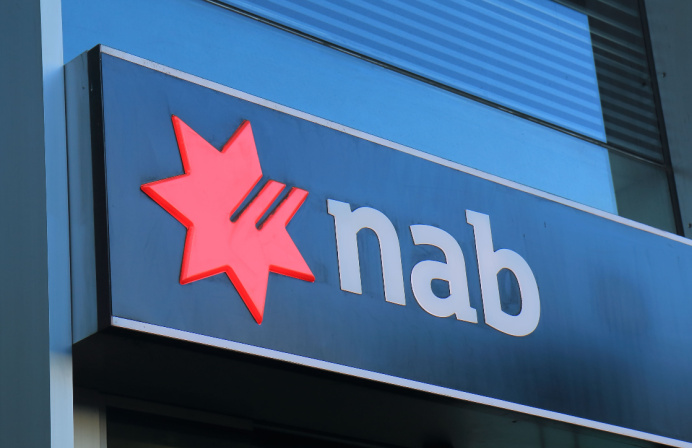
At our recent Sydney Banking Summit, AMP’s Jacqui Visch and ING Australia’s Sasitharan Sanmugaratnam, among the industry’s most respected voices in data and digital innovation, came together to explore their the digital-only banks’ tech transformation agendas and big data-readied infrastructure mix.
Here, we take a look their organisations’ response to the Covid crisis, the seamless pivot to remote working, opportunities from compliance-hardened ecosystems, and newly redefined digital and tech infrastructure strategies leveraging the banks’ vast pool of data assets.
Digital Innovation Panel:
– Jacqui Visch, Group Chief Technology and Data Officer, AMP
– Sasitharan (Sasi) Sanmugaratnam, Chief Data Officer, ING Australia
Moderated by: Dr Luke Deer, Researcher & Tutor, Finance Discipline, University of Sydney Business School
Dr Luke Deer (Moderator): Winston Churchill’s oft-quoted phrase, “never let a good crisis go to waste”, has found newfound resonance during Covid. In this time of crisis, how has your organisation leveraged newfound opportunities to adapt and re-focus their digital strategies?
Jacqui Visch (AMP): Indeed, we should never let a good crisis go to waste. And crisis is really where you see the best in people come out. If I reflect on AMP and transitioning our workforce – and we’d only really set up 1,000- 1,500 people to work from home, yet we needed to get a workforce of 8,000 across both domestic and international arms there – as the crisis evolved, it wasn’t only a challenge for AMP employees, it was also in maintaining that connectivity with our partners.
What we did was form a cross-functional group of people that had our partners, AMP experts, as well as our risk and compliance people. Every day they were looking at the next piece of the puzzle to get our employees working more effectively from home. And it was not only the technology and our ability, because we already had a lot of cloud-based infrastructure – Office 365, our virtual private network, and a lot of SaaS services, which enabled us to go at pace. But it was also taking that risk assessment of moving people from, let’s say an Indian global delivery centre, to go from that very controlled space into their work from home environment. And we needed to consider that as we did it. Because, otherwise, a number of operations across our bank personnel, across our wealth management, and also finance operations would be put at risk.
It really brought the company together and our experts to think about the goal of where we needed to go to. It didn’t matter what brand or what badge or what company they worked for. I really believe that’s how you harness that in the next phase for our employees today and employees of the future.
And we all know great client experiences are driven through amazing employees and their engagement.
And so really, it’s how do we straddle those two things?
Sasitharan Sanmugaratnam (ING): This period has been surprising and surprisingly good in many ways. It’s obviously a very challenging time for our customers and our workforce. But it’s forced us to rethink our purpose and return to some key fundamentals – to sharpen our focus and really prioritise.
[Covid] has forced us to prioritise the wellbeing of our staff as a key pillar of our organisation. It’s also about helping our customers who needed financial assistance, putting our focus more on retention and less on new business opportunities.
We’re a branchless bank to begin with, so our interactions with the outside world were very digital already. And for our employees, we’d already started moving towards flexible working before the crisis struck. But, honestly, the commitment wasn’t necessarily there from the entire workforce to transition in an effective way. It has therefore been quite an interesting experience accelerating that work from home (WFH) process, but it has had tangible successes for us.
For people who were once left out of the conversation when working from home, when compared to people working in the office, WFH has suddenly become very immersive; our meetings are more effective and we’re actually more productive.
The only challenge is that the technology is still a little bit behind in terms of what we’re using at this point in this conversation. There are some limitations and we’re now looking at innovating on that front and better enabling a mix of WFH and working in the office, which will start to come back; not spoiling that experience and making sure everybody is immersed and engaged.
And, of course, going back to Jacqui’s point, on our Indian workforce managed through some of our major partners, has also benefited from this because, again, they were a little bit disjointed to begin with; now everybody is online. The only challenge is back-to-back meetings and very busy schedules and a lack of clarity between the start and end of a day. That’s the bit that we need to deal with now, becoming more disciplined on that.
Deer (Moderator): Sasi [Sasitharan] made a point on the immersive potential of new remote working interaction channels. Given the challenge of back-office digital innovation, how have these newly digitised employee experiences sharpened your conversations around infrastructure?
Visch (AMP): It’s opened up many executives’ eyes to the art of the possible. And the criticality of investing in all layers of your technology – as in, if you’re able to move at pace and demonstrate that through cloud-type infrastructure and architectures, then you’re enabling a lot more opportunity within your business.
Just through what we did during the Covid crisis in a normal project sense, that previously would have taken maybe nine months [to complete]. We did it in about six to seven weeks.
Because we already had so much in a Software-as-a-Service mode, the speed and the ability to get there was fast-forwarded immensely.
A critical backbone of any company, though, is the network; yet most people barely know what that means. If you can educate through these crisis periods, that really goes a long way to uplifting your workforce. Then it really becomes a board conversation to help accelerate whatever digital transformation priorities your organisation has. And I always say: ‘digitisation is top-down from core to platform and bottom-up from your infrastructure and networks – so how do you achieve that data integration layer through these workflows? When those two are combined, that’s really the secret sauce.
Cultural transformation also cannot be underestimated. That shift to home probably would have taken five years in a normal cycle. We did it in three months. And I mean ‘we’ as in Australia and the world – we all did it in three to four months. So, you really think about what could have been in five years or what we did do in three years. What would happen if we just rip the band-aid off and be really clear on what the art of the possible is in this space?
Sanmugaratnam (ING): We already had a fairly well-developed pipeline of enhancements covering our infrastructure side. We’re also working on priorities for enhancing our customer experience, and continuing to build on some of the digital successes we’ve had in the past. But one thing we are very cognizant of in this current environment is the importance of getting the foundations right.
In a highly regulated industry, it’s vitally important to get the basic elements of data right – having the right data capture and following that lifecycle through properly before we start to leverage that data for more interesting things.
Maybe the one difference between what we would have done pre-Covid and what we’re doing now is just taking a little bit more time and getting those foundations right. And then, probably some time over the course of next year, we’ll start to accelerate the innovation on that.
Deer (Moderator): On the question of foundations, there’s been a lot of talk around digital innovation with partners of late, from APIs, sandboxes, and accelerators. But where are you finding challenges with regard to integrating your in-house infrastructure, particularly in connecting your back-offices to the front?
Sanmugaratnam (ING): Some of the use cases that we’ve already been successful with, they’re very isolated; but given pockets of data, it’s relatively straightforward to do a proof of concept and show some value. But the real value comes from orchestrating all of that data – whether it’s internal data in relation to our workforce or customer-related data, that remains a big challenge, because it requires a major refresh and modernisation of underlying platforms.
There is, of course, the opportunity to move towards cloud infrastructure. We already have it in a private environment, and private cloud has some of those capabilities. But it’s inevitable that we will transition eventually. So, we’ll look at those opportunities. But for me, ultimately, it’s a data problem. It’s making sure all of our data is brought together to really make decisions and interactions with our customers fully informed, as opposed to in just very specific use cases. It is a significant challenge.
Deer (Moderator): So, then, is the right foundation for that core infrastructure – one that supports data integration efforts – predicated on a transition to cloud?
Visch (AMP): There is so much convergence, whether you’re talking infrastructure or you’re talking data. And if I just start with the data aspect, amazing data companies know their data; they control their data. They have clear metrics around what is data quality, their reference data, their data definitions; it is like gold to them. That is the thing that will make them amazing.
Core to any digital transformation is actually data governance, your data ownership, and data stewardship.
On the other side of that is then around saying, ‘Well, where do we pull and push all of this data through our various systems in a way that’s meaningful, secure, robust, and at speed?’
Those companies that have got more legacy – those born 120, 150, 170 years ago – have built up silos, or specific warehouses, of business units. And now we’re in a world of aggregation. There’s actually huge value in aggregating all of that richness together. But either you’re putting rubbish in/rubbish out or you’ve got clarity on what you’re building and a really clear line of sight through your overall architecture. We can talk about ‘spaghetti’ or ‘goat tracks’, but if your data is traversing through 55 different ways up and back and being transformed all over the place, then you’re losing clarity on that.
Deer (Moderator): On the issue of systems ‘spaghetti’, the need for an integrated or ‘single customer view’ is ultimately challenged by siloed products and services. How do we break through that spaghetti to achieve this goal?
Visch (AMP): When I mentioned spaghetti, it’s really around having that clear architectural purpose-driven around the client value chain and client automation, and then asking: ‘How do I achieve these outcomes considering the net promoter score that I’m after, the products that I want to sell and my growth areas, but notwithstanding my regulation, the cost-out agenda, and simplification that every financial services organisation is trying to achieve?’ So how do you balance out those things?
You need to take both a bottom-up as well as a top-down view.
At AMP, we are looking to be cloud only.
And we do have a new data platform, which is really an ecosystem of capabilities that will service all of our administration platforms and then be able to create data models through having in-built data quality, as well as through a reporting and an analytics capability engine. And, for us, we see that as not only a really strong consolidation play – moving from five to one – but also gaining benefits from agility, security, privacy, and really using new, modern ways of constructing a data ecosystem to drive that value into the business. But, these are long games and there has got to be short wins too. So, how do you do the long game, but then incrementally add quality? I’m really passionate that quality at the source and quality as you go through will enhance trust in the organisation to continue to build out that broader ecosystem.
Deer (Moderator): Looking at data security obligations and reporting requirements when transitioning data and workloads to the cloud, there appear significantly more regulatory demands imposed on financial institutions today. How can banks best navigate this heavier handed regulatory environment?
Visch (AMP): The regulatory environment is no doubt strengthening. But I look at it as an opportunity. Whether we think about our compliance around CPS232 and CPS234, which is focused around cybersecurity, how do we build these in an automated way? In terms of cloud, how do we drive continuous compliance within our pipelines, so, as we automate, compliance is already baked into whatever is offered in the organisation? If you’re thinking of bringing in Software-as-a-Service, you’re already baking in automated controls into your ecosystem.
We are then able to move away from what was previously a very manual and legacy-based process into a much more proactive and automated construct that people can buy off-menu.
“My vision within AMP is that all of the capabilities that we serve into our business teams are actually available in a marketplace. And within that marketplace, they already have privacy by design, security by design, compliance by design. And then how do you actually use these regulatory regimes to influence your automation agenda within your organisation?”
So, we’re not having to manually add, change or deviate – we’re actually doing it once and using it many times.
Sanmugaratnam (ING): The challenge here is that we’re a bank with already significant customer base – and that applies to AMP as well. Trust is a big component of this. That’s something we have to defend. On the other hand, a new player has a lot more flexibility in the type of technology and the type of infrastructure that they’re able to accelerate with.
There’s a bit of a balance that we need to strike here, because we’ve got to make sure that we’re meeting the standards that our customers expect of us while we transform those capabilities and potentially explore partnerships as well.
We don’t want to be the inventors of everything.
We have a core banking service to provide much of what we want. But where there’s an opportunity to work with others that can provide the other side – the technology and some of the more innovative ways to interact with our customers – we’ll take advantage of that. But it’s a bit of a balancing act.
This is an abridged extract from the Digital Innovation Panel featured at FST’s Banking Summit, Sydney 2020.





